
DSB, an abbreviation of Danske Statsbaner, is the largest Danish train operating company, and the largest in Scandinavia. While DSB is responsible for passenger train operation on most of the Danish railways, goods transport and railway maintenance are outside its scope. DSB runs a commuter rail system, called the S-train, in the area around the Danish capital, Copenhagen, that connects the different areas and suburbs in the greater metropolitan area. Between 2010 and 2017, DSB operated trains in Sweden.

DGI-byen is a facility that houses various spa facilities, restaurants, hotels, conference facilities, a bowling alley, flexible multi-centres, sports clubs, a superellipse shaped swimming pool and Vandkulturhuset,, located in central Copenhagen, Denmark.

Aarhus Central Station is the main railway station serving the city of Aarhus, Denmark. Serving as the main connecting hub for rail traffic between Aarhus and the rest of Denmark, the station is used by an average of 6.3 million people per year, making it the busiest station in Denmark outside the Copenhagen area. It is located in the city centre between the districts of Midtbyen and Frederiksbjerg with entrances from Banegårdspladsen and the shopping centre Bruun's Galleri, and with access to platforms from M.P. Bruuns Gade.

Padborg station is a railway station in the Danish town of Padborg in the southern part of Jutland. The station is located on the Fredericia–Flensburg railway line and is the last Danish train station before the border with Germany which lies immediately south of the station. To the west, Tønder in Denmark on the route to Niebull is a further border station.

Randers railway station is a railway station serving the town of Randers in the East Jutland metropolitan area, Denmark.

Godsbanen is a cultural centre in central Aarhus, Denmark since 2012. The site and most of the buildings are a former goods station, known as "Aarhus Godsbanegård", which was in use from 1923 to 2000. It is located at the end of a broad sidetrack to the central railway yard of Aarhus. In December 2010, Realdania announced that the area would be gradually transformed into a modern city district, through a collaborative project with Aarhus Municipality. Apart from the new cultural centre of Godsbanen, there are plans to build several buildings and institutions along the former railway yard, including a new school of architecture.
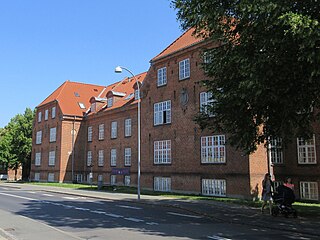
Roskilde Barracks, now known as Kildegården, is a former military barracks on Helligkorsvej in Roskilde, Denmark. The buildings are now owned by Roskilde Municipality and used as a hub for local sports clubs and other public associations and societies.
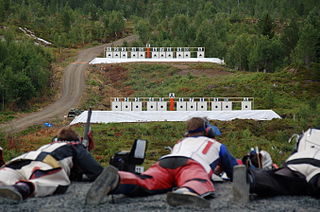
Stangskyting, literally Stang-shooting named after Colonel Georg Stang (1858–1907), is a practical rifle competition popular in Norway where dueling shooters have two periods of 25 seconds to get as many hits as possible on a target at an unknown distance, with an unlimited number of rounds. Competitions in Norway are arranged by Det frivillige Skyttervesen.

The Aarhus–Randers railway line is a 59.2 km (36.8 mi) long standard gauge, double track railway line in Denmark which runs between the cities of Aarhus and Randers in East Jutland. It constitutes a section of the East Jutland longitudinal railway line, the through route along the east coast of the Jutland Peninsula from the German border at Padborg to the port city of Frederikshavn in North Jutland.
De Danske SkytteforeningerDDS founded in 1862 was Denmark's oldest sports organization until it was merged with Danske Gymnastik- & Idrætsforeninger 1 January 2013. After the merger DDS was split in two with DGI Skydning administering competitions, weapons registration, political and organizational issues, while Skydebaneforeningen Danmark handles advice and financial support to clubs and shooting ranges.

Spanien Public Baths, colloquially known simply as Spanien, is a public bath house and a listed building in Aarhus, Denmark. The bath house was completed in 1931 and was listed on the Danish national registry of protected buildings and places by the Danish Heritage Agency on 15 February 1989 as a fine example of the Nordic funkis style. The building was thoroughly renovated in 2010–12.

Aarhus Old City Hall is the former city hall of Aarhus, Denmark, and a listed building. The city hall was built in 1857 and was listed in the Danish national registry of protected buildings and places by the Danish Heritage Agency on 18 March 1996. It is the second, and oldest preserved, city hall of Aarhus.

Stykgodspakhuset, or Pakhus 13, is a former warehouse and a listed building in Aarhus, Denmark. The warehouse was built in 1926 and was listed in the Danish national registry of protected buildings and places by the Danish Heritage Agency on 4 April 2006. The warehouse is situated on the water front of the Port of Aarhus in the central Indre by neighbourhood next to the Custom House and has functioned as a storehouse for parcels and other small cargo since completion to the mid 20th century. The building is today used for offices after extensive renovation in 2007.

The Aarhus Central Workshops is a complex of listed buildings in Aarhus, Denmark and is the former DSB central train repair facility for Jutland and Fuenen. The buildings were completed in 1862 and was listed by the Danish Heritage Agency in the Danish national registry of protected buildings and places on 11 November 2005. The complex includes the central workshop building and the smithy (Smedjen). The building complex is situated in the central Indre By neighborhood close to the Aarhus Central Station.
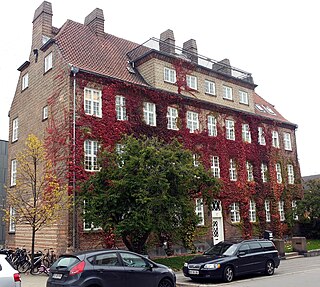
The Baumann House is a listed building in Aarhus, Denmark. The building was constructed in 1911 and was listed in the national Danish registry of protected buildings and places by the Danish Heritage Agency on 18 September 1996. The building is situated in the central Indre By neighborhood on Jægergårdsgade adjacent to the Aarhus Central Workshops.

The Jutland Racecourse is a public racecourse in Aarhus, Denmark. The racecourse is situated on Observatorievejen adjacent to the Aarhus Sports Park in the Aarhus C district north of Højbjerg.

The architecture of Aarhus comprises numerous architectural styles and works from the Middle Ages to present-day. Aarhus has a well-preserved medieval city center with the oldest dwellings dating back to the mid-1500s and some ecclesiastical structures such as St. Clemen's Cathedral and numerous smaller churches that can be traced back to the 1100s. The industrialization of the 19th and 20th centuries left distinctive industrial structures, important National romantic works and some of the best examples of Functionalist architecture in the country. The history of the city as a Viking fort is evidenced in the street layout of the Latin Quarter, the wider Indre By neighborhood testifies to its later role as a Market town and center of commerce while the Frederiksbjerg, Trøjborg and Marselisborg districts showcase the first cohesive urban planning efforts of the early 20th century.
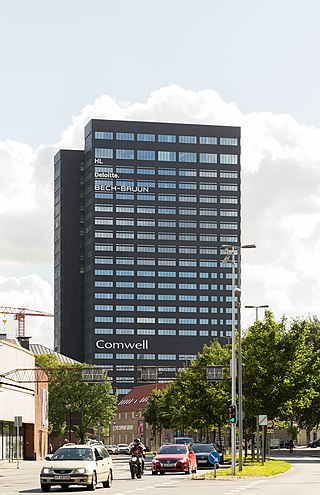
Aarhus City Tower is a building on Værkmestergade in Aarhus, Denmark and it is one of the tallest buildings in both the city and Denmark at large. At 94 meters it is the second tallest building in Aarhus after Aarhus Cathedral and, as of 2016, it is the fourth tallest building in Denmark. Aarhus City Tower is used as a Comwell hotel, offices and for conferences. Aarhus City Tower was built by the Danish businessman Hans Lorenzen through the contractor KPC with Rambøll as the engineer and Arkitema as the architect. The building is 25.000m² spread across 25 floors with an additional 13.000m² subterranean parking garage. It is the tallest building constructed in Aarhus since the 1930s when the cathedral got its 96 meter tall spire. The other floors has been rented by Bech-Bruun, Deloitte and the Danish hotel chain Comwell. The Comwell hotel has 240 rooms and conference facilities for 1000 people.
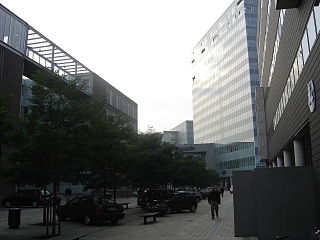
EY Huset is a building on Værkmestergade 25 in the Indre By neighborhood in Aarhus, Denmark. It is one of the tallest buildings in Aarhus and Denmark at large. At 68.5 meters it is the fourth tallest building in Aarhus after Aarhus Cathedral, Aarhus City Tower and Ceres Panorama. As of 2017 it is the 16th tallest building in Denmark. EY Huset is a mixed use building with condominiums on the top two floors, offices on the following 10, stores on the next 2 while the bottom 3 are various miscellaneous. The high-rise was built as a part of the commercial department store project Bruun's Galleri. The building is 17 floors tall and is situated directly behind Aarhus Central Station surrounded by buildings that are generally lower.
The Danish shooting movement was a movement in that started in Denmark around the 1860s after inspiration from the National Rifle Association of the United Kingdom which had been founded in 1859 to provide voluntary firearms training for the purpose of national defense.




















